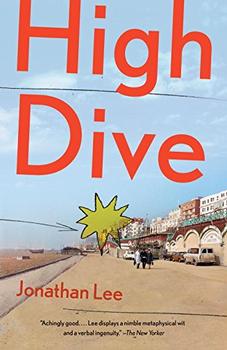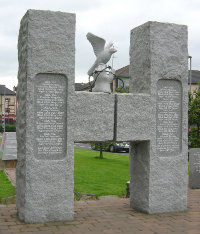Summary | Excerpt | Reviews | Beyond the Book | Read-Alikes | Genres & Themes | Author Bio

This article relates to High Dive
In High Dive, Jonathan Lee references many aspects of "The Troubles," a term used to describe the turbulent decades in Northern Ireland between 1960 and 2000. At issue was a territorial challenge: the overwhelmingly Protestant Loyalists wanted to remain part of the United Kingdom while the nationalists and mainly Catholic republicans were looking to secede and become part of the Republic of Ireland.
The novel frequently references the Maze prison north of Belfast, the notorious H-block section of the Maze and to the death there, in 1981, of Bobby Sands.
The Maze, also known as Long Kesh, or simply the Maze, was built on an airfield and opened in 1971 as an internment camp to house prisoners and paramilitary offenders arrested and detained without trial as part of the British government's response to unrest in Northern Ireland. At one time, as many as 1800 men and women were imprisoned there. The facility, closed since 2000, was once known as "the university of terror," and in separate buildings housed terrorists from both Loyalist and Republican sides of the struggle. In an article in The Telegraph written when the prison closed, a former prisoner said, "We went in bad terrorists and came out good terrorists. We learned how to strip and handle weapons, how to make booby-trap bombs, how to stand up to interrogation and, basically, how to be a professional terrorist."
 Within the Maze, during 1975, several H-shaped buildings, called H-blocks were constructed, each with four small wings of 25 cells. From 1976, prisoners detained as part of the Troubles were detained in the H-blocks with criminal, rather than political, prisoner status. This policy caused huge unrest within the facility. Prisoners refused to wear uniforms in what became known as the "blanket protests." Conditions within the H-blocks became notorious with reports of cells with walls smeared with excrement and having nothing more than dirty mattresses on the floor.
Within the Maze, during 1975, several H-shaped buildings, called H-blocks were constructed, each with four small wings of 25 cells. From 1976, prisoners detained as part of the Troubles were detained in the H-blocks with criminal, rather than political, prisoner status. This policy caused huge unrest within the facility. Prisoners refused to wear uniforms in what became known as the "blanket protests." Conditions within the H-blocks became notorious with reports of cells with walls smeared with excrement and having nothing more than dirty mattresses on the floor.
At the beginning of the 1980s, protests within the prison came to a head with a hunger strike. The prisoners demanded the right to wear their own clothes, time to associate with other prisoners, the right not to work and access to leisure activities.
 The first to die as a result of the protests was Bobby Sands. Sands was born in north Belfast in 1954 and lived in a largely Loyalist part of the city until the family members were forced from their home because of their perceived Republicanism. Shaped by the times, like Dan in High Dive, Bobby Sands joined the IRA at the age of 18. He was arrested twice when found in possession of a firearm, resulting in prison terms: for three years in the early 1970s and then for 14 years starting in 1976.
The first to die as a result of the protests was Bobby Sands. Sands was born in north Belfast in 1954 and lived in a largely Loyalist part of the city until the family members were forced from their home because of their perceived Republicanism. Shaped by the times, like Dan in High Dive, Bobby Sands joined the IRA at the age of 18. He was arrested twice when found in possession of a firearm, resulting in prison terms: for three years in the early 1970s and then for 14 years starting in 1976.
Sands began his hunger strike in the Maze on March 1, 1981. Five days later, the death of an independent Republican Member of Parliament meant there would be an election for the British parliamentary seat of Fermanagh and South Tyrone. Bobby Sands became a candidate standing, from prison, against a member of the Ulster Unionist Party. In the election on April 9, Bobby Sands was elected to the Houses of Parliament in London. Sands' win was an important moment in the history of the political arm of the Republican movement, Sinn Féin, which grew to be the largest political party in Northern Ireland by the turn of the century.
Despite Sands' win, the British government, led by Margaret Thatcher, stood fast on prisoner terms. Sands continued to refuse food inside the Maze prison and after 66 days he died on May 5, 1981. Riots broke out across Northern Ireland and 100,000 people followed his funeral cortege. His coffin was flanked by masked men in paramilitary outfits.
While Bobby Sands remains the most famous of the Maze prison hunger strikers, nine other men also died, the last, Michael Devine, on August 20 1981.
Picture of H-Block Monument in the Free Derry area of the Bogside, Derry; in memory of the hunger strikers in the H-Block of Long Kesh prison in 1981.
Filed under Places, Cultures & Identities
![]() This "beyond the book article" relates to High Dive. It originally ran in March 2016 and has been updated for the
February 2017 paperback edition.
Go to magazine.
This "beyond the book article" relates to High Dive. It originally ran in March 2016 and has been updated for the
February 2017 paperback edition.
Go to magazine.




It was one of the worst speeches I ever heard ... when a simple apology was all that was required.
Click Here to find out who said this, as well as discovering other famous literary quotes!
Your guide toexceptional books
BookBrowse seeks out and recommends the best in contemporary fiction and nonfiction—books that not only engage and entertain but also deepen our understanding of ourselves and the world around us.